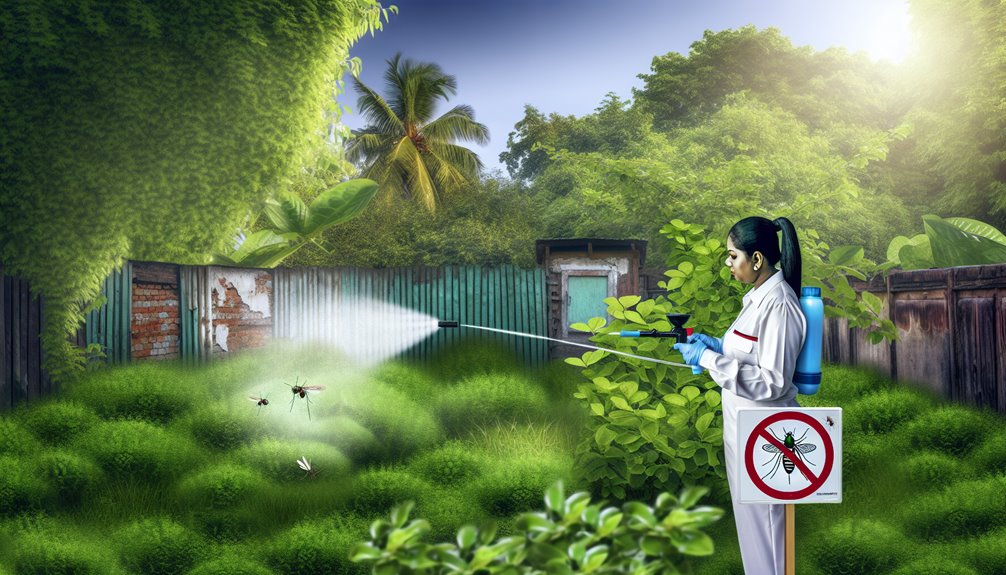You expect a mosquito treatment to last, and a “free respray” sounds reassuring—but it has limits. Most guarantees cover retreatment if activity stays above a set threshold within 14–30 days, and only in defined zones. You’ll need to grant timely access, follow post-service instructions, and avoid unapproved pesticides. Standing water or major landscaping changes can void coverage. Knowing what’s excluded—and what triggers eligibility—helps you use the guarantee effectively, but there’s a catch you should confirm first.
What a “Free Respray” Really Means

Although “free respray” sounds straightforward, it’s a specific service remedy with defined eligibility, timing, and scope. You request it when post-treatment mosquito activity exceeds the stated threshold within the guaranteed window. You document conditions, allow access, and confirm you didn’t disrupt the barrier (e.g., heavy irrigation, new yard work). We verify treatment duration and product label intervals before scheduling. Respray frequency follows regulatory limits and your service plan, not preference. We target approved zones, adjust nozzles, and record lot numbers, weather, and application rates. You’ll receive post-service guidance to preserve efficacy and comply with reentry times, drift controls, and notification rules.
Typical Coverage in a Mosquito Treatment Guarantee
When you read a mosquito treatment guarantee, focus on what it covers: the treatment zones, performance threshold, time window, and remedy. You’ll verify which areas are included—perimeter foliage, shaded harborage, and standing-water sites—and which are excluded for safety or regulation. Most guarantees define a measurable reduction threshold and a claim window aligned to mosquito season. You must follow prep steps and allow reentry intervals. Providers specify treatment frequency, minimum service intervals, and weather constraints. If results fall below the threshold, the remedy is a no-cost retreatment, not a refund. Document activity, submit photos, and schedule within the stated timeframe.
How Long Results Should Last After a Service

Expect results to hold for 14–30 days per application, with variability driven by product residual, weather, and site conditions. You should calibrate service expectations to the labeled residual of the active ingredient and your property’s pressure. Heavy rain, high heat, and dense vegetation can shorten treatment longevity. Monitor activity objectively and document conditions to support timely service adjustments.
- Inspect harborage weekly; note shade, moisture, and foliage density.
- Reduce standing water; refresh birdbaths every 3 days.
- Maintain vegetation; trim undersides to improve coverage persistence.
- Schedule follow-ups per label intervals; avoid unapproved retreatment timing.
Eligibility Criteria for a No-Cost Retreatment
Results should persist 14–30 days under labeled conditions; if activity rebounds sooner, you may qualify for a no‑cost retreatment based on objective triggers and documentation. To meet eligibility requirements, you must: confirm service date, product used, and target zones; submit timestamped observations (bites, resting adults) within the service window; and verify no unreported standing water sources emerged. We’ll assess traps or landing‑rate counts against thresholds. Your treatment frequency plan must be current, with invoices paid and scheduled intervals maintained. Provide access for inspection within two business days. We’ll document findings, recalibrate nozzles or mix rate if warranted, and perform a compliant retreat.
Conditions That Can Void the Guarantee

Although the guarantee is robust under labeled conditions, specific actions or site changes can void it. You’ll protect service value by honoring common exclusions and your client responsibilities. Maintain documented site conditions, follow label directions, and report changes promptly so we can serve you compliantly and effectively.
- Unauthorized pesticide use or off‑label applications between visits alter residues and void coverage.
- Uncorrected water sources (clogged gutters, tarps, birdbaths) sustain breeding and invalidate retreatment.
- Significant landscaping, construction, or foliage removal after treatment changes exposure profiles and cancels guarantees.
- Missed access windows, withheld pets/people clearance, or failure to follow post‑treatment instructions breach safety protocols and nullify eligibility.
What’s Not Included in Most Guarantees
While our treatments target labeled mosquito species and habitats, most guarantees don’t cover conditions, pests, or outcomes outside the product label and service scope. Here’s an exclusions overview: non-mosquito pests (gnats, midges, ticks), untreated neighboring sources, standing water you control, weather events beyond label tolerance, landscaping changes, construction, or unapproved products applied by others. Structural entry points and indoor biting aren’t included. Performance claims beyond EPA-approved directions are excluded. Service windows and retreat frequency follow label limits, not unlimited visits. Common misconceptions: guarantees aren’t refunds for nuisance levels, barrier breaches, or event protection, and they don’t override local regulations.
Steps to Maximize Your Provider’s Promise
Before your first service, document baseline conditions and align expectations with the product label and service agreement so you know exactly what’s guaranteed. Capture photos of standing water, shade density, and entry points. Record dates, weather, and conducive conditions to support provider accountability and calibrated customer expectations.
- Verify product labels, reentry intervals, and application sites; validate the treatment plan matches labeled directions and local ordinances.
- Remove breeding sources you control; note any exclusions outside your control.
- Log each service outcome within 24 hours; quantify mosquito activity.
- Submit respray requests within the stated window; include evidence, site changes, and safety constraints to expedite compliant follow‑up.
Key Questions to Ask Before You Book
What exactly will the provider guarantee, and under which label, ordinance, and contract terms will they perform? Ask for the specific efficacy window, trigger for free resprays, and service response time. Confirm permitted treatment types, active ingredients, application rates, and EPA/State label compliance. Verify technician licensing, insurance, drift controls, and buffer rules. Request a site map showing treated zones and exclusions. Clarify standing-water management and source reduction steps. Get a written cost comparison showing per-visit price, season total, and respray fees. Determine cancellation terms, weather delays, and neighbor notifications. Ask how complaints are documented, verified, and resolved within the guarantee.
Conclusion
As the owner of Mosquito Eliminators of South MS, I truly understand how important it is to enjoy your outdoor space without the nuisance of pesky mosquitoes. I hope this information helps clarify how our free resprays work and how you can ensure your treatment remains effective. If you have any questions or would like to learn more about our services, please don’t hesitate to visit us at mosquitoeliminatorsms.com or give us a call at (601) 336-2277. We’re here to help you reclaim your yard and enjoy the great outdoors with confidence!

